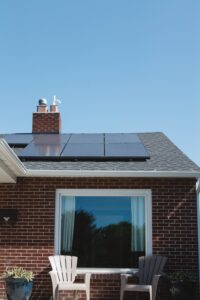
Pursuant to Directive (EU) 2018/2001 of the European Parliament and of the Council of 11 December 2018 on the promotion of the use of energy from renewable sources, and a measure from the National Recovery and Sustainability Plan of Bulgaria, and after serious debates and changes in the draft bill initially proposed by the government, amendments to the Energy from Renewable Sources Act (ERSA) and to the Spatial Planning Act (SPA) were adopted with a supplemental bill promulgated in the State Gazette Issue 42 as of 7th of July, 2022 (the ERSA supplemental bill)[1]. With these amendments, effective as of 07.06.2022, a significantly simplified procedure for the construction of facilities for the production of electricity from renewable energy sources (RES, renewables) for own consumption was introduced.
Who can benefit from the simplified procedure?
According to the newly adopted Art. 25a of ERSA, those who can benefit from the simplified procedure are all end customers – household and non-household customers who buy electricity for their own consumption and who are already connected to the electricity transmission or electricity distribution network (including closed electricity distribution networks), i.e. the procedure refers to all persons who have concluded contracts with an operator for connection to any of the above networks.
For what type of facilities, for what purposes and for what capacity can the simplified procedure be used?
Considering the new Art. 25a of ERSA refers to location of installations on roof and facade structures of buildings connected to the transmission or the distribution electricity network (regardless of their purpose – production, residential, public service, warehouse, etc.), in practice the new procedure would be applied primarily to the construction of rooftop and facade photovoltaic installations for the generation of electricity. However, as far as the said provision uses the general term for energy facilities for the generation of energy from RES, other types of facilities for the generation of energy from such sources could also be built under this procedure – be it wind generators, solar power plants, sites for the production of aerothermal and geothermal energy, hydroelectric energy, biomass energy, etc. Such conclusion follows also from the fact the law allows for construction of such energy facilities also in the real estate adjacent to the buildings connected to the grid (i.e. on the undeveloped parts of the land to the buildings), but on the condition they are located in urbanized areas.
A specific requirement for benefitting from the simplified regime for the construction of such energy facilities is the electricity produced by them to be used by the end customers for their own consumption only. From the motives of the draft bill and from the transcripts of the parliamentary debates on its adoption it gets clear that the purpose of this requirement is to avoid the risk the electricity generated by facilities built under the simplified procedure (or the surplus exceeding the end customer’s own consumption) to be transferred into the transmission or the distribution electricity network without a preliminary study of whether the network could bear a load with such an additional amount of energy. In this regard, and in result of the debates on the adoption of the bill, the final version of the ERSA supplemental bill explicitly provides that the energy produced by the energy facilities built by the customers under the simplified procedure can be transferred into the relevant electricity network only after the general procedure for connection of a client as a producer of electricity is carried out, requiring, among others, a preliminary study of the possibilities for connection to the grid and issuance of an opinion thereof by the respective network operator.
The maximum total installed capacity of the energy facilities built under the simplified procedure is limited to the double amount of the electrical capacity already provided to the customer upon his connection to the network. In all cases, however, the installed capacity may not exceed 5 MW (corresponding to the maximum installed capacity for which, according to the law, no electricity production license is required).
What are the reliefs for construction of such energy facilities?
First and most important – there is no procedure for preliminary study of the conditions for connection and issuance of an opinion on the connection of the customer as a producer to the respective electricity grid.
For the fact that it comes to construction of energy facilities necessary for the generation of energy for own consumption of sites already connected to the electricity network, instead of the complex and lengthy administrative procedures of preliminary study and obtaining an opinion on the possibilities of connection from the network operator, a simple-notification procedure has been introduced.
Thus, the procedure begins with the submission of a notification by the customer to the respective transmission or distribution network operator. Within 14 days of receiving the notification, the network operator, to whom the notification is addressed, shall provide the customer with a draft of a supplemental agreement to the contract for access and transmission through the network, setting out the technical requirements to the scheme for connection of the energy facility to the electrical system of the end customer and the rights and obligations of the parties in view of preventing the transfer of electricity to the grid and disturbances thereof. This supplemental agreement is a necessary condition for issuance of a construction permit for the energy facility.
Second – no approval of an investment design is required for issuance of a construction permit.
With the parallel changes introduced by the ERSA supplemental bill to the SPA, the latter envisages that no approval of an investment design is necessary for issuance of a construction permit for the new facility, which saves considerable efforts and costs of the clients, as well as their time. So, the client shall submit an application (under a template) to the competent municipal administration (usually a unit to the chief architect of the municipality) at the location of the energy facility to be constructed, which shall be accompanied by an opinion of a design engineer and/or an electrical engineer with drawings, diagrams, calculations and instructions for the implementation of the installations, as well as by the supplemental agreement with the network operator. Given the diverse local practice that is often observed, the relevant municipal administration, which would be competent to authorize the construction of the facility, may require further documents from the investor. Therefore, the full set of the necessary documents could be specified only when it is known where the facility will be built.
And last but not least – facilities built under this procedure are not subject to commissioning.
By virtue of the changes introduced in the SPA, the energy facilities built under the simplified procedure of ERSA are classified as constructions of the sixth category thus not being subject to commissioning by the municipal or state bodies (while such is applied by law to constructions of the first to the fifth category inclusive). In this way, one more of the usual steps in the investment process, associated with significant costs for the consumers, administrative burden and time, is abolished.
This article does not constitute legal advice, and its main purpose is to inform about the changes in the regulatory framework discussed in it, without analyzing their effect and interaction with other regimes and provisions of the current legislation.
For further information contact:
Aleksandar Aleksandrov, Senior Associate
aleksandar.aleksandrov@kdp-law.com
[1] At the time of the publication of this article, a draft bill on the amendment of the SPA has been submitted to the Bulgarian Parliament, which provides for additional procedural benefits for facilities for the production of electricity from RES up to 10.8 kW installed capacity for own needs, which is being discussed by parliamentary committees.









